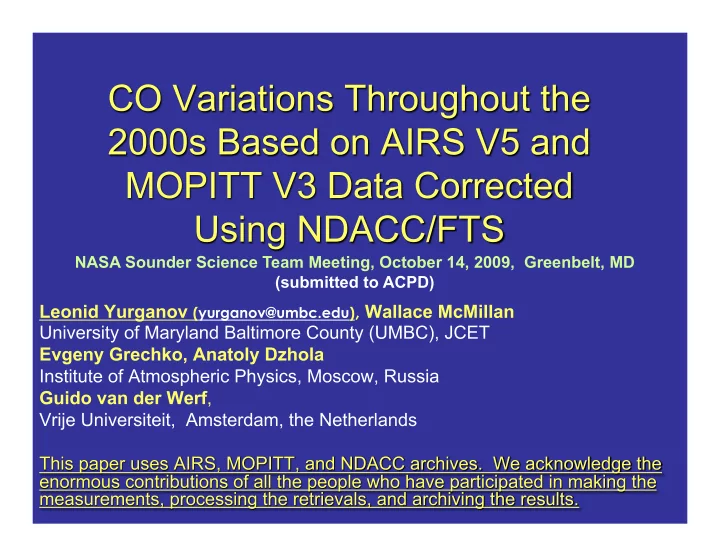

NASA Sounder Science Team Meeting, October 14, 2009, Greenbelt, MD (submitted to ACPD)
Motivation • CO is important not only by itself, but as a proxy for biomass burning, anthropogenic activity, CO 2 emissions, etc. • Space platforms and instruments have limited life-times. Thus, continual ongoing consistent validation is required to produce a long-term record. • Campaign-like aircraft sampling validation must be complemented by ground-based validation using reliable remote sensing facilities.
Milestones of the paper: validation • Daily mean data from 7 low altitude Fourier Transform Spectrometers (FTS, or FTIR) in both hemispheres were used for validation between 2000 and 2007. • The original Level 3 CO daily mean total column (TC), for day and night, measured by AIRS v5 and MOPITT v3 were compared with daily mean TC measured by FTSs on matching days. Obtained from NASA DISC and NASA LaRC archives. • Convolution of FTS TC with averaging kernels has not been applied • Annually averaged biases were subtracted from the original satellite data.
Milestones of the paper: analysis • Corrected CO monthly mean burdens (total mass in Tg, or Mt) over mid-latitudes (Northern and Southern), and tropics were compared and analyzed. • Anomalies of the burdens were calculated and compared with anomalies of biomass burning emissions independently derived by Guido van der Werf (Netherlands).
Locations of the Network for Detection of Atmospheric Composition Change sites
Bias (sat minus FTS) vs Info Content (percent of a priori for MOPITT and DOF for AIRS) Northern Hemisphere Black, day Red, night Day only for FTS MOPITT AIRS 80 Bias, % MOPITT AIRS 0 -80 Information content Information content A PRIORI
Northern Hemisphere zoomed in Bad Good Bad Good A PRIORI (Percent a priori)
Southern Hemisphere A PRIORI MOPITT AIRS Black, day Red, night
Entire comparison, sounder vs FTS +10% +10% -10% Black, day Red, night MOPITT: OK for SH AIRS: overestimation for SH underestimation for NH winter underestimation for NH winter
Bias vs time Northern Hemisphere Southern Hemisphere Annually averaged biases are subtracted from data in what follows
CO burden (Tg) before and after correction NH 30 o N … 70 o N, Tropics 30 o S… 30 o N
CO burden (Tg) before and after correction Southern Hemisphere and global
What happens to the AIRS algorithm for low CO?
Entire comparison after correction +10% -10%
Corrected CO long term variations
Global burden and emission anomaly . What is the cause of the 2008-09 low CO burden? Burden anomaly Emission anomaly R E F E R E N C E GFED2 [van der Werf et al., 2006] is a global gridded inventory of biomass burning gaseous emissions
Fewer fires in the tropics are responsible for the lower tropical CO burden GFED2 emission anomaly CO burden anomaly
GFED2 emission and burden anomalies over 3 areas Fires in Indonesia and Brazil were fewer than usual .
For NH this does not work: NH fires do not matter.
CO and CH4 anomalies in ppb in the Northern Hemisphere Methane, BL FT CO, FT ESRL data courtesy Ed Dlugokencky, NOAA BL SGP data are retrieved from AERI spectrometer (in preparation for ACPD)
CONCLUSIONS • MOPITT v3 and AIRS v5 each have their own drawbacks: MOPITT is unstable, AIRS is hardly sensitive to the lowest CO in SH. We hope that both of these can be fixed. • Global and regional CO burdens (after deseasonalizing) between 2000 and 2008 are disturbed by changes in wild fires. • In 2008-2009 a diminution of NH CO did occur. This might be caused by the economic recession, but influences of fewer wild fires in Brazil and Indonesia can not be ruled out. • Thank you!
Recommend
More recommend